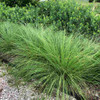Sporobolus compositus (S. asper) - TALL DROPSEED
Native dropseeds, quite common in natural remnants, but not common in gardens.
Reminds a bit of Prairie Dropseed - it is clumping grass with fibrous roots, but the flowering stems have tight (closed flowers for the most of the time), and are not fragrant).
Fall color is coppery-brown.
Blooming Time: August to October
Size: 3’ high x 1.5-2’ wide
USDA Zones: 3 to 9
Culture: sun, average garden soil, loam, clay, drained soils (rocky soil, sandy soil, gritty). Avoid waterlogged soils.
Moisture Needs: dry, medium-dry, medium
Origin: native wildflower to most of the USA, except of Florida and some western states. Usually is found in good quality habitats, high disturbance will make it decline. Can be found in prairies, plains, meadows, pastures, savannas, glades, open woodlands
Deer/Rabbit Resistant: yes/yes
Attracts Butterflies or Pollinators: no, but host plant for several grasshoppers (Velvet-striped, Pasture Grasshopper and Handsome Grasshopper)
Attracts Hummingbirds: no, but seeds provide winter food for some granivorous songbirds (Slate-Colored Junco, Lapland Longspur, Smith Longspur, Field Sparrow, White-Crowned Sparrow, and others) and probably for some upland gamebirds too
Pot Size: square 3.5" x 4" deep perennial pot
Plant combinations: naturalistic garden, native gardens, bird gardens, xeric site (dry), deer resistant plantings, slopes that tend to dry out, prairie plantings, matrix plantings.
Good perennial companions can be native perennials like Artemisia, Agastache (‘Blue Fortune’ , A. nepetoides), Asclepias tuberosa, Baptisia, Callirhoe, Coreopsis, Eryngium, Penstemon, Pycnanthemum, Liatris, Silphium terenbinthinaceum .This Echinacea looks good when combined with plants that remind of thistles, such as these non-native perennials: any Eryngium (E. planum, E. giganteum ' Big Blue',…), Echinops, Knautia macedonica, but also with Geranium sanquineum, Perovskia or Salvia nemorosa.
Pictures copyright: US perennials

Sporobolus compositus (S. asper) - TALL DROPSEED
Native dropseeds, quite common in natural remnants, but not common in gardens.
Reminds a bit of Prairie Dropseed - it is clumping grass with fibrous roots, but the flowering stems have tight (closed flowers for the most of the time), and are not fragrant).
Fall color is coppery-brown.
Blooming Time: August to October
Size: 3’ high x 1.5-2’ wide
USDA Zones: 3 to 9
Culture: sun, average garden soil, loam, clay, drained soils (rocky soil, sandy soil, gritty). Avoid waterlogged soils.
Moisture Needs: dry, medium-dry, medium
Origin: native wildflower to most of the USA, except of Florida and some western states. Usually is found in good quality habitats, high disturbance will make it decline. Can be found in prairies, plains, meadows, pastures, savannas, glades, open woodlands
Deer/Rabbit Resistant: yes/yes
Attracts Butterflies or Pollinators: no, but host plant for several grasshoppers (Velvet-striped, Pasture Grasshopper and Handsome Grasshopper)
Attracts Hummingbirds: no, but seeds provide winter food for some granivorous songbirds (Slate-Colored Junco, Lapland Longspur, Smith Longspur, Field Sparrow, White-Crowned Sparrow, and others) and probably for some upland gamebirds too
Pot Size: square 3.5" x 4" deep perennial pot
Plant combinations: naturalistic garden, native gardens, bird gardens, xeric site (dry), deer resistant plantings, slopes that tend to dry out, prairie plantings, matrix plantings.
Good perennial companions can be native perennials like Artemisia, Agastache (‘Blue Fortune’ , A. nepetoides), Asclepias tuberosa, Baptisia, Callirhoe, Coreopsis, Eryngium, Penstemon, Pycnanthemum, Liatris, Silphium terenbinthinaceum .This Echinacea looks good when combined with plants that remind of thistles, such as these non-native perennials: any Eryngium (E. planum, E. giganteum ' Big Blue',…), Echinops, Knautia macedonica, but also with Geranium sanquineum, Perovskia or Salvia nemorosa.
Pictures copyright: US perennials


